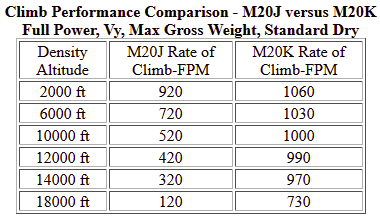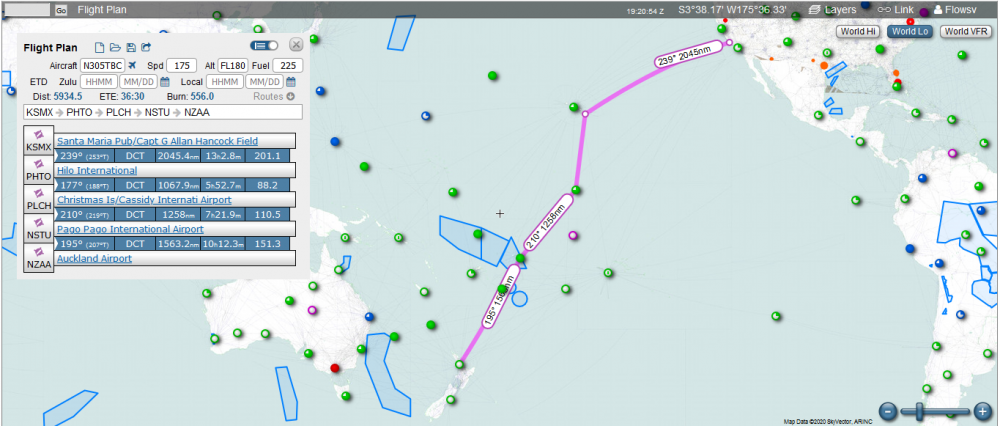-
Posts
23 -
Joined
-
Last visited
Content Type
Profiles
Forums
Blogs
Gallery
Downloads
Media Demo
Events
Everything posted by Flow
-
Mooniacs, indeed we have been scheming. Thanks for the mentions.
-
Do you have the tables for that?
-
Guys guys guys, great comments and the Bold method and Machado articles are a good start but this is a POF question about why a particular TN Mooney's Vy INDICATED INCREASES with altitude (the opposite of what the texts explain) I have edited the OP for emphasis. No other aircraft I know of does this. Maybe Mooney's are special, maybe just this one TN J. I understand, especially the latter Mooneys, have pretty much the best turbo installations in GA aircraft of the era so maybe they actually are. What special characteristic is it that allows them to defy the textbooks is the question. What the actual answer is will be very interesting. The best I can see so far is that turbo power-plant efficiency increases (a lot) with altitude, but does it? Anyone with a late(ish) model turbo want to go and play test pilot and report real world Vy at 5000 - 6000 and 18,000 - 19,000... for science...
-
Thank you, we do keep coming back to reduced exhaust back pressure due to reduced ambient pressure and therefor greater pressure drop over the turbine, cooler induction charge, and a net boost increase so at sea level you maybe getting a 6" boost above ambient while at 20,000 you are 24" above ambient or 20" if your MAP has dropped back to 32. I have added the pictures from the Pprune post to the OP above.
-
I don't know what to say, I see that is true but why would they do that? Simplicity I guess. That puts paid to the idea that the power plant is more efficient at 20,000ft and shows why the climb rate falls away so much on a 231. Maybe with a 30" max TN style application rather than 40" it is able to hold MAP up that high with the same very leaky design. But I am still not understanding the factors in play that could generate additional additional stretch north in Vy away from unpowered (trust 0) V (AoA) min sink. TAS yes IAS, not getting it.
-
That is interesting, thanks. What the IAS is doing here in the real world is the key, vertical speed also being a TAS.
-
Yep thanks, aware and good article but the question is about POF not airmanship.
-
So this comment is the closest answer? "As to why it would increase in this case maybe the power plant is more efficient as we have dramatically reduced the OAT, added ~8psi to the pressure differential over the turbine wheel and the waste gate is now closed. With a Turbo Normalized installation with automatic waste gates you should be wide open throttle the whole way up so maybe we are seeing more power dragging Vy north, but by 5% total and maybe over 10% further stretched away from min sink? Possibly?" Is there any data on TN performance increase with altitude?
-
Hello folks, I posted this on PPrune about why a TN J seems to have its indicated Vy INCREASE (backwards from what you would expect) as it climbs. No one really seems to have cracked it. https://www.pprune.org/tech-log/633530-factors-cause-vy-increase-altitude.html So are there any Turbo drivers here that notice their best rate of climb tends to occur at a faster IAS as the get into the flight levels. That is before the wastegate shuts. If so does anyone know why this happens?
-
Hi folks, it doesn't look like the owner is a member here. Does anyone know this aircraft per chance? https://flightaware.com/resources/registration/N252WT https://www.controller.com/listings/aircraft/for-sale/33127231/1986-mooney-m20k-305-rocket Here is a bit more context as well.
-
Cheers! Is the owner a member here per chance?
-
This one might do it. Does anyone know the aircraft at all? https://www.controller.com/listings/aircraft/for-sale/33127231/1986-mooney-m20k-305-rocket
-
Hey folks does anyone know this aircraft? https://barnstormers.s3.amazonaws.com/media/docs/305KM_For_Sale_buNTTQg.pdf For New Zealand we really need the epoxy coated frame however...
-
Full thread creep but hey it's bumping the topic! From what I have gathered from MSers. As you can see it resolves a number of issues peculiar to the Rocket at the cost of engine out glide angle ie, range and energy required to flare. - ~34lbs lighter on the nose = CoG and payload improvements. Small improvement here have large percentage gain for the Rockets. Handling, trim drag, payload, stall speed, weight on nose wheel etc, etc. - Pumps more air through the cowling for better climb cooling due to airfoil shape at root. - Noticeably better air brake allowing faster approach speeds if needed for ATC separation, even steeper descents if needed, better short field landing performance due to better float control. Anyone been able to pull off a + 7 degrees landing flap field approval? (Dreaming) - Better climb and take off performance - Slightly improved high altitude cruise performance - Slightly reduced low altitude cruise performance - Meaningful negative impact on engine out glide performance. The Cirrus guys talk about going from 9.6:1 to < 8:1 which of course they don't care about but has a meaningful impact on landing options for that particular emergency in an aircraft without a parachute. I have spoken to MT and they will do a feathering hub for an extra 12lbs but this (re-)introduces another potential emergency on take off with the prop governor failure mode being to feather rather than go to fine pitch.
-
It is! And not to be sniffed at. It is a proper adventure and you need to be well prepared. If you limit to Part 91 and exclude helicopters... from NTSB data. 73% of ferry pilots that ditch survive the splash down and the sea survival. 87% of ditchings result in all souls saved. 93% of forced landings on land result in no fatalities though injuries including burns are a lot higher. This is Paul Bertorelli on ditchings http://www.equipped.com/ditchingmyths.htm While in Australia I tracked down Ray Clamback to talk about his 300 or so deliveries from the US to Australia and New Zealand and his two open water ditchings http://www.equipped.com/1199ditch.htm That route is a probably the most typical avgas route to NZ though I think some are avoiding Cassidy these days as you have to position fuel there in advance. East is way, way harder from a handling, not getting shot down, mugged, ripped off, sold barrels of avgas full of water etc. perspective and a lot more expensive. You can go North and through Russia and Asia if range is limited but the water is much colder and land is not that much safer to land on in an engine out scenario. Sea survival, temps, sea state, shipping movements, inReach PLBs and ground crews, tropical CBs, limited approach nav aids, Hobbits and real life Dragons you have to contend with Westbound. Believe it of not SEP can actually be safer then MEP when so tanked up that one engine will not keep you in the air even in ground effect for the first 1/4 of the leg. Lots to think about, and a real achievement to get done safely, even with GPS.
-
I do like what you have done with yours PJ, very nice.
-
Pitter patter.. PM sent!
-
G'day Henry, I am based a little south of Auckland and happy to help any way I can. Now, do you want to find me a Rocket and fly it down?? ;) https://mooneyspace.com/topic/32955-wtb-rocket-with-epoxy-primer/
-
Indeed... Glider pilot... I knew that foward CoG would be good for something.
-
Hello from New Zealand folks, I am in the market for a Rocket preferably a 1986 on example or one that has had the frame epoxy primed as part of a repaint. It doesn't have to be too fancy just an honest, well maintained, regularly flying example with good engine data is what I am looking for. An owner that was up for an adventure flying it to New Zealand and having a holiday on us flying it around here before handing over would be the match made in heaven. https://skyvector.com/?ll=6.891525890546765,-127.79296875192452&chart=302&zoom=16&fpl=N0175F180 KSMX PHTO PLCH NSTU NZAA Morning mists in our valley
-
Thanks J, glad to hear that Mooneys can zero out. Spot on sir, glider towing slow... plus a lot of holes.. everywhere.
-
I have been flying with one of these clipped to my shoulder strap with audio and vibration alerts. https://www.amazon.com/Sensorcon-Inspector-Industrial-Monoxide-Detector/dp/B01M9GJANZ?ref_=ast_bbp_dp The only aircraft that have not registered any CO in the cockpit have been gliders and a DA42. Culprits include Tecnam P2002, Robin 2160, Lancair 360, Glasair III, CT4 Airtrainer, C152 Aerobat, Piper Arrow, Archer III (esp with AC running), Pawnee (over 60ppm), Grob 109, Aeroprakt A22 and 32 et al. I am thinking this is one of the reasons I can go 4 hours in a Glider at all sorts of altitudes on O2 (or not) with competition stressors and not and feel it but single engine tractors can have quite a grog factor even on a 40 min aeros sortee. With use of the sniffer attachment I have managed to isolate and resolve CO leaks on a number of those and found some to be lost causes. Also finding a mechanic that has experience with tracking and resolving CO issues is still pretty tough though on the improve now.










